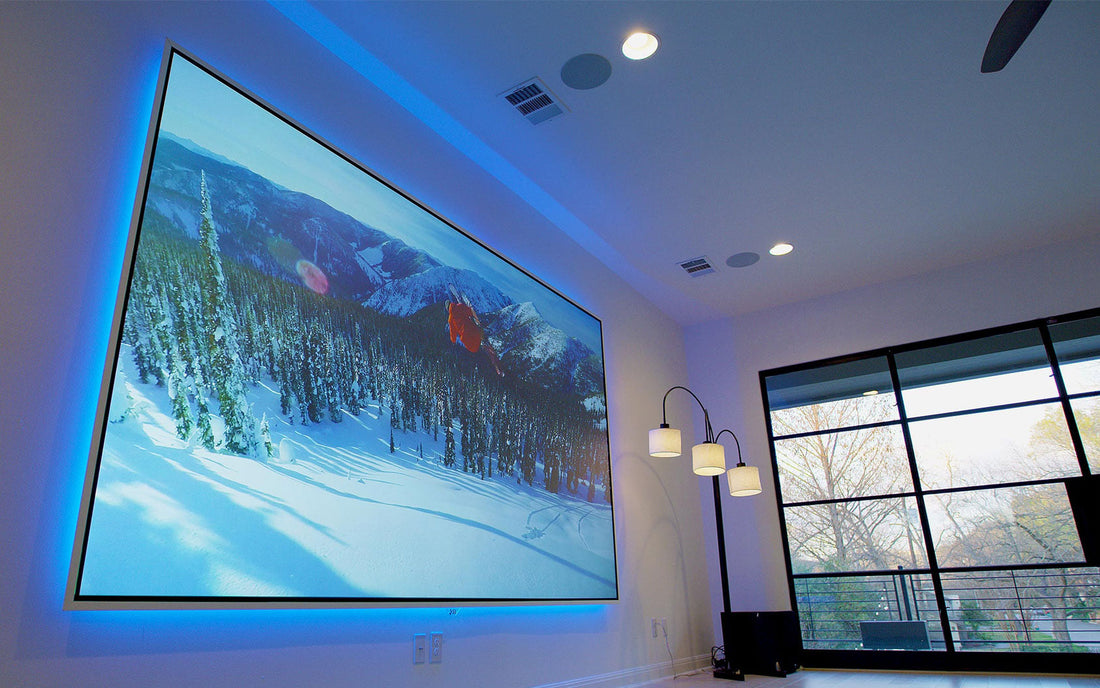
Decoding Projector Screen Fabrics: Your Guide to the Perfect Viewing Experience
Ron StotzShare
Hello, tech enthusiasts, movie buffs, and presentation experts! Have you ever wondered how to elevate your viewing experience? The secret ingredient isn't just your projector—it's the screen fabric too.
Let's navigate through the myriad projector screen options available, to help you find the perfect one for your needs.
Matte White Screens: Known for their versatility, Matte White Screens are the unsung heroes of projector screens. With a wide viewing angle and excellent color reproduction, these screens are fantastic for controlled lighting environments like home theaters, conference rooms, or classrooms.
Pros:
- Provides a wide viewing angle, making it great for larger audiences.
- Accurate color reproduction, making visuals more authentic and immersive.
- Ideal for rooms with controlled lighting conditions.
Cons:
- Not the best choice for rooms with a significant amount of ambient light as it can wash out the image.
High Contrast Screens: Struggling with ambient light in your living room or gaming setup? High Contrast Screens come to the rescue! Designed to enhance image contrast and black levels, these screens ensure deep blacks and vibrant colors, regardless of the lighting situation.
Pros:
- Enhances image contrast and black levels, leading to more vibrant and dynamic visuals.
- Specially designed to handle ambient light, ideal for living rooms and gaming setups.
Cons:
- Color accuracy might be slightly compromised due to enhanced contrast.
Ambient Light Rejecting (ALR) Screens: Even the sunniest rooms are no match for ALR Screens. These screens have a unique way of rejecting ambient light from various angles while reflecting the projected light, resulting in superb image quality—even in bright settings.
Pros:
- Advanced optical technologies selectively reflect projected light, ensuring great image quality.
- Highly efficient in combating ambient light, perfect for bright environments.
Cons:
- May have limited viewing angles compared to other screens.
Acoustic Transparent Screens: Sound quality is just as important as picture quality, right? Acoustic Transparent Screens let the sound pass through without sacrificing visual quality—an absolute boon for dedicated home theaters where audio-visual harmony is essential.
Pros:
- Seamless integration with audio systems, creating a unified audio-visual experience.
- Allows sound to pass through without compromising visual quality.
- Ideal for venues where audio quality is paramount, such as theaters and concert halls.
Cons:
- Slightly more expensive due to the specialized construction.
- Might have slightly less sharp visuals due to perforations.
3D Screens: 3D enthusiasts, this one's for you. With specialized coatings that maintain light polarization, 3D Screens provide enhanced depth perception and image clarity—a must-have for 3D cinemas, gaming arenas, and virtual reality setups.
Pros:
- Specialized coatings maintain light polarization, improving depth perception and image clarity.
- Ideal for enhancing 3D viewing experience.
Cons:
- Not the best choice for standard 2D projections.
Rear Projection Screens: Perfect for retail displays, exhibitions, and presentations, Rear Projection Screens are a space-saving wonder. They project the image from behind the screen, giving you a clear, unobstructed viewing area.
Pros:
- Ideal for space-constrained environments where traditional front projection isn't feasible.
- Offers a clear, unobstructed viewing area, ideal for retail displays and large-scale presentations.
Cons:
- Generally, requires more equipment and precise setup than front projection
screens.
Motorized Screens: The beauty of automation comes to life with Motorized Screens. With a simple touch, you can deploy or retract the screen—ideal for multi-purpose rooms, corporate environments, and high-end home theaters.
Pros:
- Convenience of automation for easy retraction or deployment.
- Smooth and quiet operation enhances user experience.
Cons:
- Might require professional installation.
- Higher cost compared to manual screens.
DIY Screens: If you enjoy customization or are looking for a budget-friendly option, DIY Screens are your best bet. Choose from a variety of materials, such as blackout cloth, spandex, or muslin - add a PVC frame and you can create your unique viewing canvas.
Pros:
- Offers customization options to fit specific needs.
- Typically more cost-effective than commercial screens.
Cons:
- Requires some effort and technical know-how to set up.
- The quality of the final result depends on the materials used and the precision of the setup
Inflatable Screens: Planning an outdoor movie night or event? Inflatable Screens are your portable and easy-to-set-up solution, offering a range of sizes to suit both small gatherings and large-scale outdoor screenings.
Pros:
- Portable and versatile solution for outdoor movie nights and events.
- Quick and easy to set up.
Cons:
- Weather-dependent, may not work well in windy or rainy conditions.
- Not as durable as other screen types.
Remember, choosing the right projector screen fabric can significantly influence your visual experience. Factors such as viewing angle, ambient light, audio requirements, and portability all play a part in your decision. With the knowledge of each screen type's unique features, you're well-equipped to make the right choice.
If you have more questions or need help getting started on your dream home theater, give us a call or send us a message today!
FAQ
1. Q:
A:
2. Q:
A:
3. Q:
A:
4. Q:
A:
5. Q:
A:
6. Q:
A:
